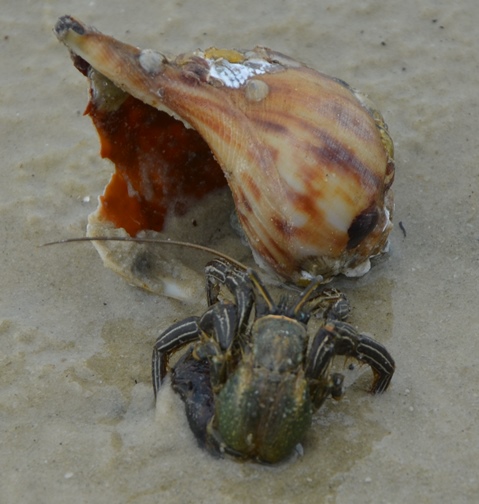Summertime in north Florida is good. Among the premium experiences are leisurely hours at the beach.
For many this is a period of relaxation and the opportunity to casually examine what the surf has thrown on the beach. It can be the culmination of a summer vacation or a weekend reprieve from the contemporary insanity of 2015’s workaday grind.
The hermit crab is one commonly encountered native creature which is slow-moving and hard to miss observing. It scuttles along the shallow coastal waters in search of its immediate needs.
In most cases it is the next meal which prompts this member of the Pagurus genus to fitfully crawl about in the borrowed disguise of a gastropod. They are not particular which shell they occupy just so long as it fits their size and is transportable.
Likewise, they are not especially particular about their meals. Hermit crabs are omnivores which relentlessly scavenge for anything digestible in the shallow waters of much of the world.
Their family includes about 1100 members which differ in size, color and housing choices. Some, in other regions, will even lodge in immovable locations and depend on the tidal currents to provide for their nutritional requirements.
When times are good and the hermit crab has plenty to eat, it will outgrow it’s the shell which fate provided for its use. The search for a replacement requires probing, luck and can produce aggressive behavior between hermit crabs if appropriately sized shells are in short supply.
Without the shell a hermit crab is an easy meal for other denizens of the deep. If the shell is too small, the hermit crab cannot grow properly or withdraw into the shell completely which exposes it to the unending stream of predators.
The upper portion of their bodies is covered with a hard exoskeleton, but their abdomen is soft and vulnerable to attack. The long and pliable abdomen is useful for firmly holding to a vacant snail shell which provides the necessary protection.
The technique has proven very successful for the hermit crabs as a whole. Fossil records indicate these crustaceans have existed since the last days of the dinosaurs.
While hermit crabs live alone in the shells they procure, they are commonly found in colonies and compete for a variety of necessary resources and mates. Their collective activity has attracted the attention of many young beach goers.
The small, shy creatures have held unending fascination for generations of children. The hide and seek nature of their behavior retreating into shells at the first appearance of a threat increases the enticement.
The temptation to return home with a unique and diminutive pet has proven irresistible for many. One can only guess how many parents have first learned of their child’s decision by the aroma of a deceased hermit crab.
It is a good thing the visit to the beach is relaxing. To learn more about hermit crabs contact the nearest UF/IFAS Extension Office.
- Pokeweed: Adding Purple to the Fall Palet - September 27, 2019
- Wakulla Springs Offers The Biggest, And The Best, Natural Florida Experience - January 4, 2019
- Silent Night It Is Not!!! Cicadas Sing the Evening Away. - October 26, 2018

